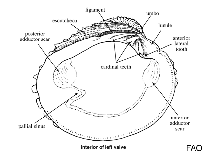Humilaria kennerleyi (Reeve, 1863)
Kennerley venus| Native range | All suitable habitat | Point map | Year 2050 |

|
| This map was computer-generated and has not yet been reviewed. |
| Humilaria kennerleyi AquaMaps Data sources: GBIF OBIS |
Upload your photos
Google image | No image available for this species;
drawing shows typical species in Veneridae.
Google image | No image available for this species;
drawing shows typical species in Veneridae.
Classification / Names Common names | Synonyms | CoL | ITIS | WoRMS
Bivalvia | Venerida | Veneridae
Environment: milieu / climate zone / depth range / distribution range นิเวศวิทยา
; ระดับความลึก 0 - 45 m (Ref. 95344). Temperate
การแพร่กระจาย ประเทศต่างๆ | พื้นที่จำแนกตาม FAO | ระบบนิเวศหลายระบบ | การปรากฏขึ้น,การเกิดขึ้น,พบ | การแนะนำ
Northeast Pacific: Alaska, Canada, northwestern USA.
Length at first maturity / ขนาด / น้ำหนัก / Age
Maturity: Lm ? range ? - ? cm Max length : 10.0 cm SHL เพศผู้/กระเทย; (Ref. 95344)
Life cycle and mating behavior วัยเจริญพันธุ์ | การสืบพันธุ์ | การวางไข่ | เซลสืบพันธ์ของเพศเมีย(ไข่) | ความดกของไข่ | ตัวอ่อน
Members of the class Bivalvia are mostly gonochoric, some are protandric hermaphrodites. Life cycle: Embryos develop into free-swimming trocophore larvae, succeeded by the bivalve veliger, resembling a miniature clam.
Main reference
อ้างอิง | ผู้ประสานงาน | ผู้ร่วมมือ
Bisby, F.A., M.A. Ruggiero, K.L. Wilson, M. Cachuela-Palacio, S.W. Kimani, Y.R. Roskov, A. Soulier-Perkins and J. van Hertum. 2005. (Ref. 19)
IUCN Red List Status (Ref. 130435: Version 2024-1)
CITES status (Ref. 108899)
Not Evaluated
CMS (Ref. 116361)
Not Evaluated
Threat to humans
Human uses
| FishSource |
เครื่องมือ
ข้อมูลเพิ่มเติม
Trophic Ecology
รายการอาหาร
อาหาร, โภชนาการ
การบริโภคอาหาร
อาหารสำหรับสัตว์น้ำแต่ละตัว
ผู้ล่า
อาหาร, โภชนาการ
การบริโภคอาหาร
อาหารสำหรับสัตว์น้ำแต่ละตัว
ผู้ล่า
Ecology
Population dynamics
การเจริญเติบโต
Age/Size
Length-weight
Length-length
Length-frequencies
Mass conversion
การทดแทนที่
อุดมสมบรูณ์
Age/Size
Length-weight
Length-length
Length-frequencies
Mass conversion
การทดแทนที่
อุดมสมบรูณ์
Life cycle
การสืบพันธุ์
วัยเจริญพันธุ์
ความดกของไข่
การวางไข่
เซลสืบพันธ์ของเพศเมีย(ไข่)
Egg development
ตัวอ่อน
พลวัตของสัตว์น้ำวัยอ่อน
วัยเจริญพันธุ์
ความดกของไข่
การวางไข่
เซลสืบพันธ์ของเพศเมีย(ไข่)
Egg development
ตัวอ่อน
พลวัตของสัตว์น้ำวัยอ่อน
Distribution
Human Related
ประวัติการเพาะเลี้ยงสัตว์น้ำ
Stamps, Coins Misc.
Stamps, Coins Misc.
Outreach
Taxonomy
References
แหล่งที่มาจากอินเตอร์เน็ต
BHL | BOLD Systems | CISTI | DiscoverLife | FAO(Publication : search) | Fishipedia | GenBank (genome, nucleotide) | GloBI | Gomexsi | Google Books | Google Scholar | Google | PubMed | แผนภูมิชีวิตแบบต้นไม้ | Wikipedia (Go, ค้นหา) | บันทึกทางด้านสัตววิทยา
Estimates based on models
Preferred temperature
(Ref. 115969): 6.9 - 9.9, mean 8.8 (based on 74 cells).



